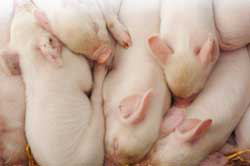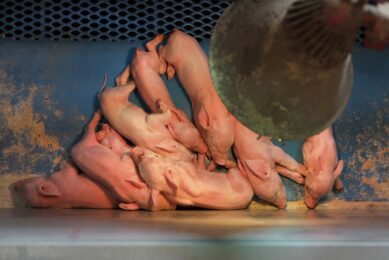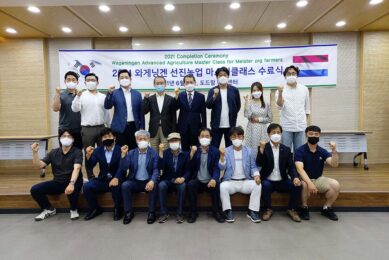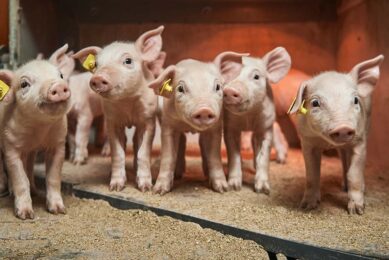Project: Reduce piglet mortality in organic pig production

Larger litter sizes and an extra kilo per pig at weaning – this is what scientists are aiming for in a new project where the primary objective is to reduce piglet mortality in organic pig production from 33 to 20%.
Fresh air and room to roam – this is everyday life for organic pigs that appear to be a contented lot as they busy around their huts in the field. There is, however, another side to the coin. One in three organic piglets dies before reaching the weaning stage. Scientists from Aarhus University will try to remedy this in a new project with the pig industry, which is funded by the Green Development and Demonstration Programme of the Ministry of Food, Agriculture and Fisheries.
Some of the measures that the scientists will be looking are the breeding of sows better suited to the organic farming conditions and improving the management and microclimate of the farrowing huts.
“These initiatives will not only reduce piglet mortality but also increase the number and weight of weaned pigs for the benefit of the farmer and the integrity of the organic pig production,” says the leader of the project, senior researcher Lene Juul Pedersen from Aarhus University. Her expectations are that piglet mortality can be reduced from one in three to one in five of the organic piglets born, that the number of weaned pigs can be increased by at least one pig and that the weight at weaning can be increased by one kilo per pig.
Piglet mortality is higher in organic pig production (33 percent) than in conventional production (23 percent). The high mortality slows the development of the organic production as it affects profitability and animal welfare.
What goes wrong?
The cause of the high mortality in organic pig herds is not known for certain. The importance of factors such as litter size, birth weight and sow health, body condition and how many previous births the sow has had have not been fully investigated in Denmark. Better monitoring at farrowing or a different design of the huts where the piglets are born may help to improve the survival rate.
The first part of the project therefore aims to identify the risk factors affecting the survival rate. The scientists will collect data from 10 organic pig farms, including information on the temperature in the hut, sow body condition and health, and piglet mortality.
Previous studies suggest that birth weight is a major contributory factor. Pigs with low birth weight are usually weaker and succumb more easily to hunger, chill and crushing by the sow. There is a negative relationship between birth weight and litter size. This means that the larger the litter size, the higher the risk that the birth weight will be low and that piglets therefore will be less robust.
Organic breeding targets
It is common practice in Denmark to use the same pig breeds for organic production as are used for conventional production. The producers typically use sows that are bred to produce large litters in the protected environment of a modern pig pen, but these breeds are not necessarily those best suited to an organic production.
Because an organic production is quite small compared to its conventional counterpart, it has been difficult to implement an effective breeding programme for organic conditions, since the pool of genetic breeding material is quite small. New genetic technologies such as genomic selection effectively change this situation. With genomic selection the existing genetic material can be put to much more effective use.
This means that it is no longer so important to have a large breeding population to draw on. This throws the doors wide open to many new options. Part of the project will therefore be preparing and testing specific breeding targets for organic sows, whereby sows for example will produce smaller litters, but just as many – or more – will survive to the weaning stage. This part of the project will take place in dialogue and cooperation with the organic pig producers.
Better huts
The proper environment for birthing is also important. Organic sows give birth in huts in a field where it is not as easy as in a conventional farrowing pen for the farmer to monitor the births or to get in to help the animals if the sow has problems.
For this part of the project, the scientists will select six promising hut designs on the Danish market and compare their ability to provide the optimal birthing environment for the sow and the piglets and monitoring facilities and access for the farmer.
“Better conditions for the animals will improve animal welfare, the farmer’s economy and boost the integrity of organic pig production vis-à-vis the consumers,” says Lene Juul Pedersen.
The four-year project has been granted 10m DKK from the Green Development and Demonstration Programme of the Ministry of Food, Agriculture and Fisheries. Besides Aarhus University – the project leaders – participants include Udviklingscenter for Husdyr på Friland (Development Centre for Free-range Farm Animals), Knowledge Centre for Agriculture and six organic pig producers.
The project, called VIPiglets is an Organic RDD2 project, funded by the Ministry of Food, Agriculture and Fisheries and coordinated by the International Centre for Research in Organic Food Systems (ICROFS).
Further information: Senior researcher Lene Juul Pedersen, Department of Animal Science, email: Lene.JuulPedersen@agrsci.dk, phone: +45 8715 7907
Source: Janne Hansen, Aarhus University
 Beheer
Beheer








 WP Admin
WP Admin  Bewerk bericht
Bewerk bericht